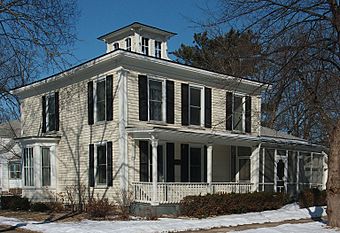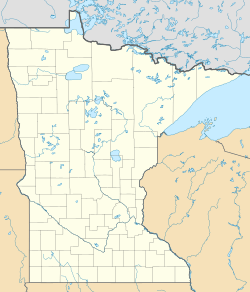Ignatius Eckert House facts for kids
Quick facts for kids |
|
|
Ignatius Eckert House
|
|

The Ignatius Eckert House from the southeast
|
|
| Location | 724 Ashland Avenue, Hastings, Minnesota, United States |
|---|---|
| Area | Less than one acre |
| Built | 1850s |
| Architectural style | Cupolated Italian Villa |
| NRHP reference No. | 78003071 |
| Added to NRHP | July 21, 1978 |
The Ignatius Eckert House is a very old and special house in Hastings, Minnesota, United States. It was built a long time ago, in the early 1850s. What makes it unique is its beautiful design. It's known for its "Italian Villa" style and a cool little tower on top called a cupola. This house is so important that it's listed on the National Register of Historic Places.
A Historic Home in Hastings
The Ignatius Eckert House is a famous building in Hastings, Minnesota. It was first built in a different town, Nininger, Minnesota. This happened in the early 1850s. Later, in 1857, the house was moved to Hastings. Thomas Reed, who owned the house at the time, was the one who moved it.
What Makes It Special?
The house is listed on the National Register of Historic Places because of its amazing architecture. It's a great example of the Italian Villa style. This style often includes a square shape and a low-pitched roof. A special feature of this house is its cupola. A cupola is a small, dome-shaped tower on the roof. It often has windows and lets light into the house.
The design of the house also shows the ideas of Andrew Jackson Downing. He was a very important person in American landscape design. He wrote about "Country Homes" and how houses should fit into their natural surroundings. The Ignatius Eckert House is a good example of his ideas.
Who Lived Here?
The first owner of the house was Reverend G. W. T. Wright. He was a minister at the nearby Hastings Methodist Episcopal Church. This shows that important people lived in this house from the start.
Later, around 1909, a man named Ignatius Eckert bought the home. He was a farmer who had retired. The house is named after him today.



